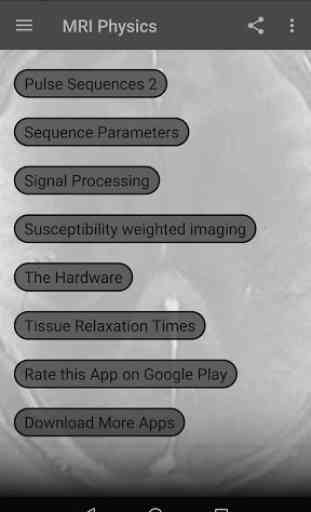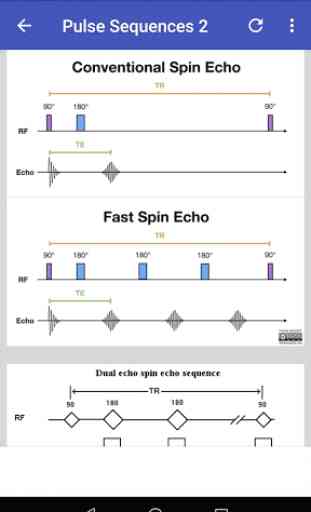Magnetic Resonance Imaging (MRI) Physics
App content:
MRI History
Why Use MRI?
Opportunities in MRI
The Imaging Hardware
Magnetism
Physics
Pulse Sequences Overview
Diffusion weighted imaging
MR perfusion weighted imaging
CSF flow studies
Functional MRI (fMRI)
Susceptibility weighted imaging
MR angiography and Venography
MR spectroscopy (MRS)
MR fingerprinting
MR enterography and MR enteroclysis
Sequence Parameters
Signal Processing
MR image quality
MRI contrast agents
MRI contrast agent safety
MRI Artifacts
MRI safety
Acquisition Parameters
Tissue Relaxation Times
MRI Acronyms
The physics of magnetic resonance imaging (MRI) concerns fundamental physical considerations of MRI techniques and technological aspects of MRI devices. Contrast agents may be injected intravenously or into a joint to enhance the image and facilitate diagnosis. Unlike CT and X-ray, MRI uses no ionizing radiation and is therefore a safe procedure suitable for diagnosis in children and repeated runs. Patients with specific non-ferromagnetic metal implants, cochlear implants, and cardiac pacemakers nowadays may also have an MRI in spite of effects of the strong magnetic fields. This does not apply on older devices, details for medical professionals are provided by the device's manufacturer. MRI is a medical imaging technique mostly used in radiology and nuclear medicine in order to investigate the anatomy and physiology of the body, and to detect pathologies including tumors, inflammation, neurological conditions such as stroke, disorders of muscles and joints, and abnormalities in the heart and blood vessels among others.
MRI History
Why Use MRI?
Opportunities in MRI
The Imaging Hardware
Magnetism
Physics
Pulse Sequences Overview
Diffusion weighted imaging
MR perfusion weighted imaging
CSF flow studies
Functional MRI (fMRI)
Susceptibility weighted imaging
MR angiography and Venography
MR spectroscopy (MRS)
MR fingerprinting
MR enterography and MR enteroclysis
Sequence Parameters
Signal Processing
MR image quality
MRI contrast agents
MRI contrast agent safety
MRI Artifacts
MRI safety
Acquisition Parameters
Tissue Relaxation Times
MRI Acronyms
The physics of magnetic resonance imaging (MRI) concerns fundamental physical considerations of MRI techniques and technological aspects of MRI devices. Contrast agents may be injected intravenously or into a joint to enhance the image and facilitate diagnosis. Unlike CT and X-ray, MRI uses no ionizing radiation and is therefore a safe procedure suitable for diagnosis in children and repeated runs. Patients with specific non-ferromagnetic metal implants, cochlear implants, and cardiac pacemakers nowadays may also have an MRI in spite of effects of the strong magnetic fields. This does not apply on older devices, details for medical professionals are provided by the device's manufacturer. MRI is a medical imaging technique mostly used in radiology and nuclear medicine in order to investigate the anatomy and physiology of the body, and to detect pathologies including tumors, inflammation, neurological conditions such as stroke, disorders of muscles and joints, and abnormalities in the heart and blood vessels among others.
Category : Medical

Related searches




